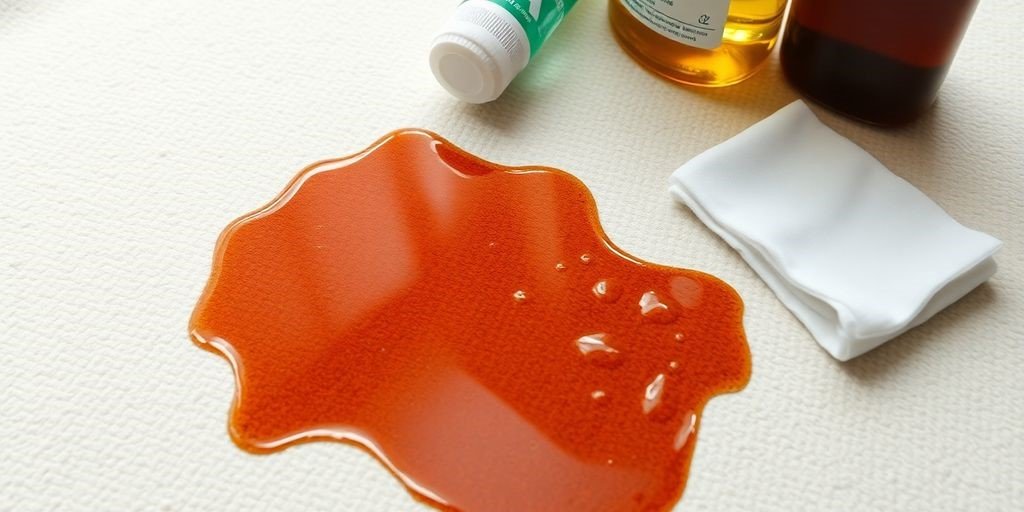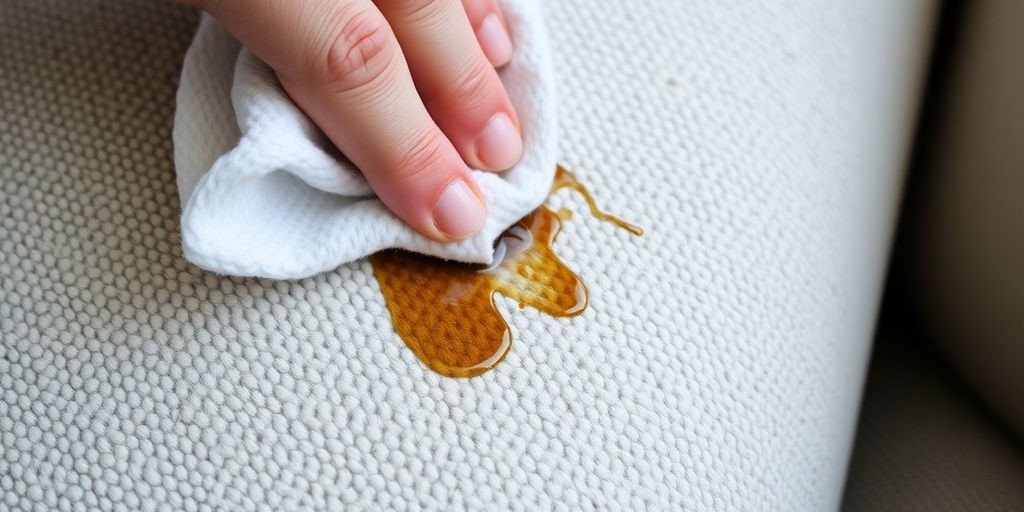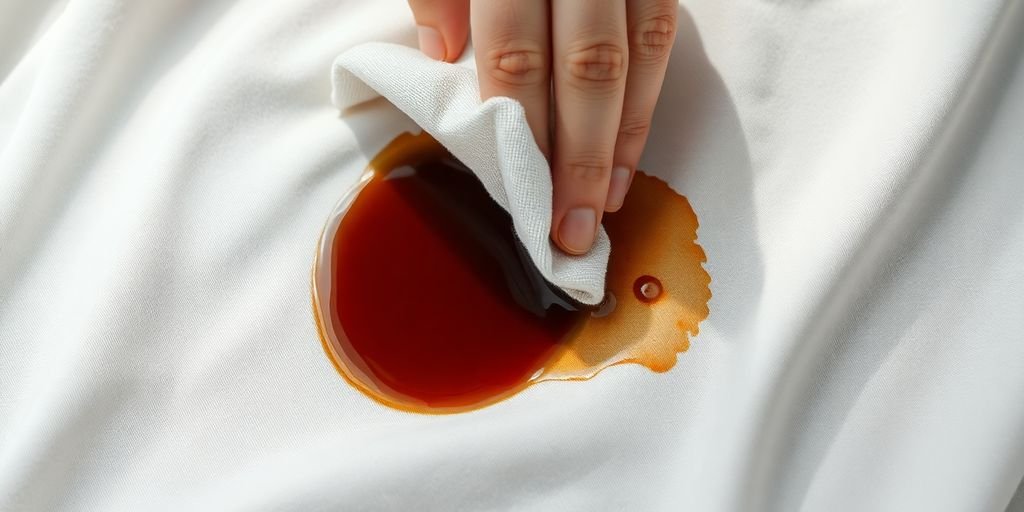Spilled coffee can feel like a disaster, especially on your favorite shirt. You might think about grabbing the strongest cleaner you have, but hold on! Using the wrong stuff, like bleach, can actually make things worse for your clothes.
This article will walk you through how to get rid of coffee stains without damaging your fabrics, focusing on methods that are safe and effective. We’ll cover everything from fresh spills to dried-on spots, so you can keep your clothes looking good.
Key Takeaways
- Coffee stains aren’t usually permanent, but you have to act fast to remove them.
- Don’t use bleach on coffee stains; it can harm your clothes and leave yellow marks.
- Avoid common home remedies like baking soda or toothpaste, as they often don’t work for coffee stains and can cause other problems.
- Always use cold water when treating coffee stains, as warm water can make the stain stick to the fabric.
- For really tough or old stains, or on delicate items, it’s smart to get help from a professional cleaner, especially for Coffee Stain Removal Denver.
Understanding Coffee Stains

Are Coffee Stains Permanent?
Good news! Coffee stains are rarely permanent. However, the longer you wait to deal with them, the harder they become to remove.
It’s all about acting fast. Think of it like this: a fresh spill is a minor inconvenience, but a dried, set-in stain? That’s a whole different ballgame. If you’re in Denver and need help, there are Coffee stain removal tips Denver available.
Why Time is of the Essence
Time really is of the essence when it comes to coffee stains. The quicker you act, the better your chances of completely removing the stain. Letting a coffee stain sit allows it to bond more strongly with the fabric fibers, making it much more difficult to lift later.
This is especially true for delicate fabrics. Don’t delay – tackle that spill ASAP! For those seeking Natural coffee stain remover options, acting quickly is even more important.
The Role of Tannins in Stains
Coffee gets its color from tannins, which are natural substances that can easily bind to fabrics. This is why coffee stains can be so stubborn. These tannins are what give coffee its dark color, and they love to latch onto fibers, creating those pesky brown marks. Breaking down these tannins is key to successful stain removal.
Consider using eco-friendly coffee stain removal Denver services to minimize environmental impact while tackling these tannin-based stains.
Why Avoid Bleach for Coffee Stain Removal

Chlorine Bleach and Fabric Damage
Chlorine bleach is a powerful chemical, but it’s not always the best solution for removing coffee stains without bleach. It can be too harsh on many fabrics. The active ingredients in chlorine bleach can break down the fibers, leading to damage, especially with repeated use.
This is particularly true for delicate materials like wool, silk, or even some synthetic blends. Always check the care label before considering bleach, and when in doubt, opt for a gentler approach.
Discoloration and Weakened Fibers
One of the biggest risks of using chlorine bleach is discoloration. While it might seem like a good idea for white fabrics, bleach can actually cause them to yellow over time. This is because the chemical process can weaken the fibers, making them more susceptible to staining and discoloration.
For colored fabrics, bleach can strip away the dye, leaving you with a faded or uneven appearance. It’s a gamble that often doesn’t pay off.
Coffee spills during busy mornings can leave behind stubborn stains that ruin your carpet’s charm.
At A1 Red Carpet, we specialize in coffee stain removal that restores the look of your floors. Our team uses safe, deep-cleaning methods to lift stains without harming the fabric. Whether it’s your living room, office, or commercial space, we handle each job with care and precision. You don’t have to live with dull, stained carpets anymore—we’ll bring back their fresh, clean look.
Common Mistakes in Coffee Stain Treatment
The Ineffectiveness of Baking Soda
Baking soda is often touted as a cure-all for household cleaning, and many people reach for it when faced with a coffee stain. However, using baking soda alone is often ineffective for removing coffee stains, especially if they’ve already set. Baking soda works by raising the pH of a stain, which helps dissolve grease and oils, but coffee stains are primarily acidic.
Risks of Using Toothpaste
Toothpaste might seem like a readily available solution, especially if you’re dealing with a coffee stain on the go. The idea is that the mild abrasives in toothpaste can help scrub away the stain. However, this approach comes with several risks.
First, the abrasives can be too harsh for delicate fabrics, potentially damaging the fibers. Second, many toothpastes contain whitening agents that can bleach or discolor the fabric, especially if it’s colored.
Harmful Home Remedies
When faced with a stubborn coffee stain, it’s tempting to try any home remedy that promises results. However, some of these remedies can do more harm than good. For example, using lemon juice on colored fabrics can cause bleaching or discoloration.
Similarly, applying harsh chemicals like chlorine bleach can weaken the fibers and ruin the fabric, especially if it’s not bleach-safe. Even seemingly harmless ingredients like vinegar can cause damage if used improperly or on certain types of fabrics. It’s important to research any home remedy thoroughly before applying it to your clothes or upholstery.
Effective Techniques for Cotton Fabrics
Cotton is a pretty forgiving fabric when it comes to stain removal, which is great news since it’s so common in our wardrobes. Unlike some delicate materials, cotton can handle a bit more agitation and stronger treatments.
Here’s a breakdown of how to tackle those pesky coffee stains without resorting to bleach.
Blotting Up Excess Coffee
Time is of the essence! The very first thing you should do when you spill coffee on cotton is to blot it up. Grab a clean cloth or paper towel and gently press it onto the stain. Avoid rubbing, as this will only spread the coffee and push it deeper into the fibers, making it harder to remove later.
Think of it like soaking up a spill on the counter – you want to lift the liquid, not smear it around. This initial step can significantly reduce the severity of the stain.
Pre-Soaking for Best Results
Pre-soaking can work wonders, especially for set-in stains. Fill a basin or sink with cold water and add a mild detergent. Let the stained garment soak for at least 30 minutes, or even a few hours for tougher stains.
This allows the detergent to penetrate the fibers and start breaking down the coffee particles. For an extra boost, you can add a bit of white vinegar to the soaking water. It’s a natural stain fighter and helps to loosen the coffee’s grip on the fabric. After soaking, gently squeeze out the excess water before moving on to the next step.
Rinsing and Repeating
Rinsing is a crucial step to remove the detergent and loosened coffee residue. Hold the stained area under cold running water, making sure the water flows through the fabric from the back of the stain. This helps to push the coffee out of the fibers rather than further embedding it.
Inspect the fabric closely after rinsing. If the stain is still visible, repeat the blotting, soaking, and rinsing steps until it’s gone. Patience is key here! Don’t be afraid to repeat the process multiple times to achieve the best results.
Water Temperature Matters for Coffee Stains
The Importance of Cold Water
When dealing with coffee stains, the temperature of the water you use is surprisingly important. Always start with cold water. I learned this the hard way after accidentally setting a coffee stain by using warm water. Cold water helps to lift the stain without causing it to bind more strongly to the fabric.
Think of it like gently coaxing the stain out, rather than forcing it to stay put. It’s a simple step, but it can make a huge difference in the final result. If you want to machine wash your clothes, you can add a detergent sheet.
Why Warm Water Sets Stains
Warm or hot water can actually make coffee stains worse. The heat causes the proteins in the coffee to coagulate, essentially cooking the stain into the fabric. This makes it much harder to remove later on. It’s like the stain gets super attached and refuses to let go.
I remember reading somewhere that warm water can cause the coffee pigments to bind to the fibers, making them harder to dissolve. So, stick with cold water to avoid this issue.
Preventing Pigment Binding
To prevent the coffee pigments from binding to the fabric, it’s best to act fast and use cold water. Here’s a quick rundown:
- Blot the stain immediately with a clean cloth.
- Rinse the stained area with cold water from the back of the fabric.
- Avoid rubbing the stain, as this can spread it further.
Using cold water is a simple yet effective way to prevent coffee stains from setting. It’s a small change that can save your favorite clothes from permanent damage.
If you’re dealing with a particularly stubborn stain, consider using an enzyme-based stain removers after the cold water treatment. This can help to break down the stain further without damaging the fabric.
Treating Dried Coffee Stains
Soaking and Pre-Treatment
When dealing with dried coffee stains, immediate action is no longer an option, but don’t worry, all hope isn’t lost! The key is to rehydrate the stain. Start by soaking the garment in cold water for at least 30 minutes, or even longer for really stubborn stains.
You can add a tablespoon of white vinegar to the water to help break down the stain. This pre-treatment is crucial for loosening the pigments before you move on to the next step.
Enzyme-Based Stain Removers
Enzyme-based stain removers are your best friend when it comes to tackling dried coffee stains. These removers contain enzymes that work to break down the proteins and tannins in the stain, making them easier to wash away.
Apply the stain remover directly to the affected area and gently rub it in. Let it sit for at least 30 minutes, or even overnight, before washing. For delicate fabrics, always test the stain remover on a hidden area first to ensure it doesn’t cause discoloration.
Machine Washing Considerations
After pre-treating, it’s time to machine wash the garment. Use cold water, as warm water can set the stain further. Choose a laundry detergent pod that is effective on stains. Before placing the item in the dryer, check to make sure the stain is completely gone.
If it’s still visible, repeat the pre-treatment and washing process. Drying the garment with the stain still present can make it nearly impossible to remove. If you’re dealing with a valuable or delicate item, consider seeking Denver stain removal services for professional cleaning.
Here are some additional tips for success:
- Always blot, never rub, to avoid spreading the stain.
- Use a soft brush to gently work the stain remover into the fabric.
- Consider using the best way to get coffee stains out of carpet if the stain is on a carpet or rug.
By following these steps, you can increase your chances of successfully removing even the most stubborn dried coffee stains and ensure Safe stain removal for fabrics.
When to Seek Professional Help

Sometimes, despite our best efforts, coffee stains simply won’t budge. Or, maybe you’re dealing with a fabric that’s too delicate to risk any DIY treatments. That’s when it’s time to call in the pros. It might seem like an extra expense, but it can save your favorite items from permanent damage.
Delicate Fabrics and Harsh Chemicals
Certain fabrics, like silk, wool, or even some rayons, are incredibly sensitive. Using the wrong cleaning product or technique can cause irreversible damage, shrinking, or discoloration. It’s always better to be safe than sorry when dealing with these materials.
If you’re unsure about the fabric content or how it will react to a stain remover, professional cleaning is the way to go. They have the expertise and specialized equipment to handle these items with care.
Stubborn Stains and Professional Cleaners
Some coffee stains are just plain stubborn. Maybe it’s an old stain that’s really set in, or perhaps the coffee had additives like milk or sugar that complicate the removal process. Professional cleaners have access to stronger, more effective stain removal agents and techniques that aren’t available to the average consumer.
At A1 Red Carpet, we specialize in professional coffee stain removal that restores the beauty of your flooring without harsh damage. Our team uses safe, effective techniques to lift deep stains and odors—leaving your carpets fresh, clean, and spotless. Whether it’s a new spill or an old stain, we’re ready to help.
Call us right now for reliable services.
Frequently Asked Questions
Are coffee stains permanent?
Coffee stains are usually not permanent. The key is to clean them quickly. The longer a coffee stain sits, the harder it becomes to remove.
Should I use hot or cold water for coffee stains?
Using cold water is always best for coffee stains. Warm water can make the coffee color stick to the fabric, making it much harder to get out.
How do you get dried coffee stains out of clothes?
For old, dried coffee stains, you’ll need to soak the item, use a good stain remover (like one with enzymes), and then wash it well. Soaking it first in cold water with a bit of white vinegar can help a lot.
Does bleach remove coffee stains from white clothes?
Yes, bleach can remove coffee stains, especially from white clothes. However, you must be careful. Only use chlorine bleach on white fabrics that say they are safe for bleach. Otherwise, you might damage the fabric or cause yellow spots.
Is baking soda effective for coffee stain removal?
No, baking soda alone isn’t very good at removing coffee stains. Coffee stains are acidic, and baking soda works better on oily stains. Using baking soda might even change the color of your clothes over time.
Can I use toothpaste to remove coffee stains?
It’s best to avoid using toothpaste. While some people suggest it, toothpaste can be too harsh for certain fabrics and might not fully remove the stain. It’s safer to stick to methods made for fabric cleaning.

